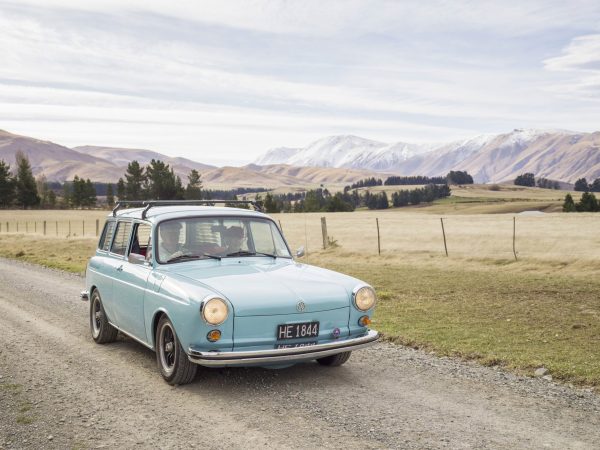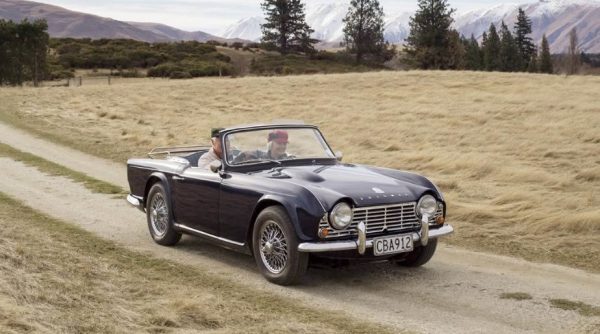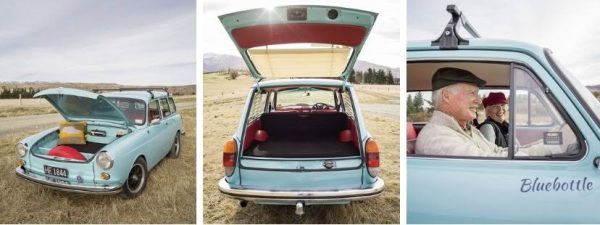Takes Two to Triumph
Two great car marques of the 1960s, Triumph and Volkswagen, keep their place in the hearts of this pair of car enthusiasts, though they are far from being the only makes in their garage. Words Kate Coughlan, Photos Rachael McKenna.

The days when Volkswagen’s noisy functionality was the antithesis of oversized and over-adorned American monsters was around the time when the Triumph TRs (Triumph Roadsters) came roaring into life. The British tractor and car manufacturer Standard sold their tractor division to Massey-Harris of Canada and set out to build sports cars to rival the world’s best.
Those days of innovative post-war motor vehicle design happily coincided with David Wright’s youth and his desire to own his first car. He chose a VW Beetle, with others to follow. And in this he traversed his home province of North Canterbury where his family farmed on the Kaikōura coast. The Beetle was not the fastest car in those days. ‘Foot to the floor, it was 70 miles per hour maximum, but it would do it all day. The Beetle was, though, the next best thing to a Land Rover for getting up challenging ski field roads.’

A busy life of farming, marriage and fatherhood followed, accompanied always by an interest in cars but with no money spare for vintage or classics until the late nineties. Then a vintage Fiat 501 and 1963 VW Beetle entered the scene and were his introduction to the realm of vintage and classic cars. The VW 63 has only recently been sold, but the interest in the early Volkswagens has now been satisfied with the purchase of a turquoise-blue 1972 Volkswagen station wagon, another example of clever German engineering.
Volkswagen’s international success with the VW Beetle and the VW Kombi, not to mention the flash brand the Karmann Ghia, inspired the company’s desire for another successful launch. The VW Type 3 was to be all about roadability, roominess and came in three head-turning styles: the fastback, the notchback and the station wagon, sometimes known as the Variant.
In a launch television advertisement for the Type 3, a very young Dustin Hoffman is besotted with its electric clock, door-to-door carpeting and air-cooled motor that can reach 84 mph. But then he can’t find the motor. ‘Ahh well,’ he says nonchalantly, ‘the mechanic will find it if necessary.’ In pursuit of the space required by post-war families, this VW has a trunk at each end of the vehicle, and beneath the rear one is where the 1500 or 1600cc engine is tucked.

David’s interest in cars continued after the passing of his first wife, and in due course a TR4 was purchased. His interest in the TRs was initially sparked due to its very close relationship with the trusty TEA Ferguson tractors which he had used on the farm. Some years later and following a move to a remote picture-postcard spot in the Manuherikia Valley (Central Otago) looking to the remarkable Hawkdun Range, the TR4 was sent to Dunedin for restoration.
A rejuvenation of more than vehicles was afoot when members of the TR club (known rather ominously perhaps as the Deep South Group) invited a past member to join them for dinner once the TR rally reached her hometown of Arrowtown. ‘I was without a TR at the time,’ reflects Lorna, ‘but when invited, relished the chance to see my car club mates again.’
David had the use of a TR3 while his TR4 was in restoration so he could participate in the Deep South Group rallies; and the dinner in question took place in an Arrowtown restaurant where the pair were seated together. Lorna recalls ‘a small table, just the two of them’, which makes David laugh. ‘It was a big, long table with everyone sitting at it, including us sitting opposite each other at one end,’ he says. What is indisputable is that they didn’t have eyes or ears for anyone else. The set-up worked and the rest is proceeding nicely into history.

These days David and Lorna manage to fit in multiple car rallies and vehicle-inspired jaunts around both islands (in one of the classic or vintage cars) with running an accommodation business, Coombes Cottage, on their beautiful St Bathans property.
While David and Lorna don’t take a perfectionist approach to the cars, they do admire the beautifully kept examples that are exhibited for concourse competitions and shows. ‘We like to drive our cars and so we will take the VW, which we have named Bluebottle (not after Spike Milligan’s alter ego but the eponymous jellyfish) to catch up with the locals on a Friday night. And the TR4 is a driver’s car,’ says David. Indeed, it was proudly marketed at its launch as the epitome of driver-centric motoring. For Lorna, her favourite car is her yellow Porsche Cayman.
A curious thing, perhaps linked to southern roads being much freer of the potholes and surface damage that beset drivers in the north, is the number of their neighbours who also have a classic car or truck tucked away in a warm shed. It certainly makes the Vulcan Hotel car park on a Friday night quite a sight for car enthusiasts!

